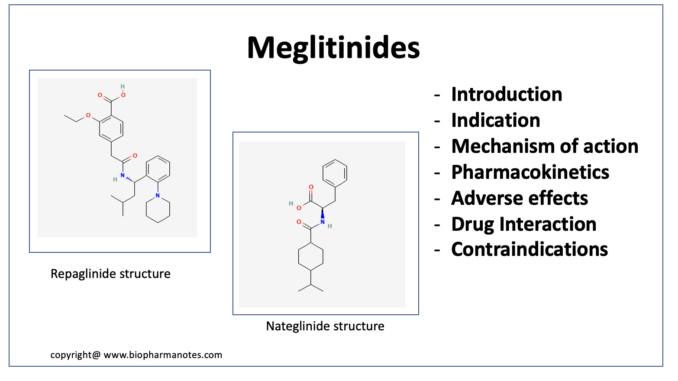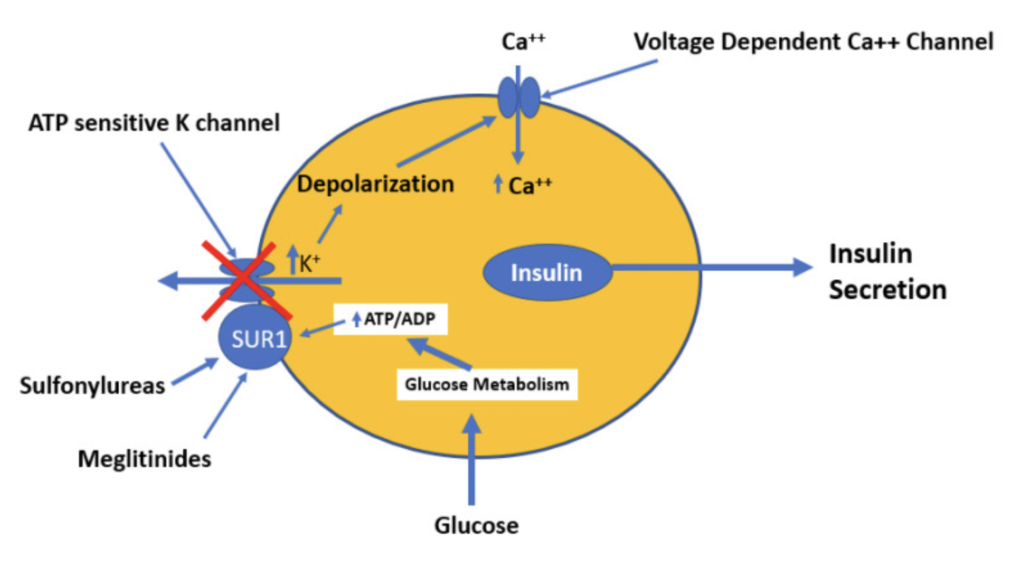
- Meglitinide which are also known as glinide are oral hypoglycemic agents. Meglitinides are chemically unrelated to another set of oral hypoglycemic agents called sulfonylurea but have same mechanism of action and similar usefulness. They were developed by addition of COOH group to nonsulfonyl urea end of glibenclamide molecule.
- They are considered as insulin secretagogues. Drugs belonging to class of meglitinide include:
- Repaglinide
- Nateglinide
- Mitiglinide
- Repaglinide and nategilnide are FDA approved whereas mitiglinide is not approved by FDA yet. Repaglinide and nateglinide are available as single entity agent and repaglinide is also available in fixed dose combination form with metformin.
Indications of meglitinide
- Used in type 2 diabetes as an adjunct to diet and exercise. They are used alone or in combination with other agents. Meglitindes have short duration of action which make them helpful in T2DM patients having irregular meal schedule and develop hypoglycemia when taking sulfonylurea.
- They can be used in diabetic patients allergic to sulfonylurea.
Mechanism of action of meglitinide

Figure- Mechanism of action of meglitinides (Source- https://www.ncbi.nlm.nih.gov/books/NBK279141/)
- They stimulate endogenous insulin production and helps to lower body glucose level. Meglitinide binds to sulfonylurea receptors linked to ATP dependent K channel (KATP) on pancreatic islet cells. This causes closing of KATP channels causing depolarization which results in calcium influx into the cell with the release of stored insulin.
- Binding site of meglitinide is different than of sulfonylurea.
Pharmacokinetics of meglitinide
- They are administered via oral route. Meglitinides have fast onset and short duration of action. Hence, they are recommended to be taken 30 minutes before intended meal.
- Metabolism takes place in liver by CYP3A4 enzymes and excretion takes place via bile.
Adverse effects
- Common side effects include hypoglycemia and weight gain. Chances of hypoglycemia is less frequent than sulfonylurea. Compared to nateglinide, repaglinide have more risk of causing weight gain and hypotension. Hypoglycemia may precipitate ischemia and closing of KATP may impair ischemic preconditioning.
- Other rare side effects include diarrhea, joint pain, sinusitis, upper respiratory tract infection etc.
Drug interaction
- Due to similar mechanism of action as of sulfonylurea, when these two agents are used together, risk of hypoglycemia may increase. Hence, concurrent use of meglitinide with sulfonylurea is contraindicated.
- Concurrent use with thiazolidinedione may increase risk of peripheral edema.
- Drugs like ketoconazole, gemfibrozil, cyclosporine may increase plasma level of repaglinide, so dose adjustment and careful monitoring is required when used with drugs like ketoconazole, rifampin, nifedipine, simvastatin, fenofibrate, cyclosporine etc.
Contraindications
- Contraindicated in patients hypersensitive to meglitinide.
- Contraindicated in type 1 diabetes and diabetic ketoacidosis.
- Should be used with caution in patients with hepatic dysfunction and in renal patients.
- Should be used with caution in pregnant and breastfeeding women.
References
- Inzucchi SE et al. New Drugs for the Treatment of Diabetes. Part II: Incretin-Based Therapy and Beyond. Circulation. 2008; 117: 574–584.
- https://www.ncbi.nlm.nih.gov/books/NBK559305/
- https://www.sciencedirect.com/science/article/pii/B9780128012383979789
- https://www.medicaid.nv.gov/Downloads/provider/Meglitinides_2013-0812.pdf
- https://journals.sagepub.com/doi/10.1177/2165079916644263
- https://www.sciencedirect.com/science/article/pii/B9780080552323621208.
- Goodman and Gillman Manual of Pharmacology and Therapeutics.
- Lippincott Illustrated Reviews Pharmacology, 6th edition.
- Pharmacology and Pharmacotherapeutics. 24th edition.